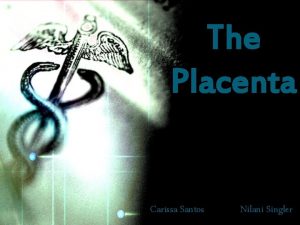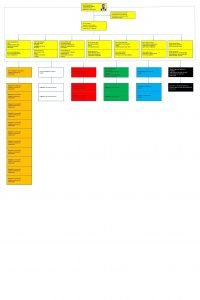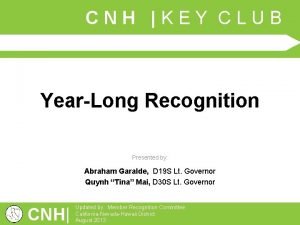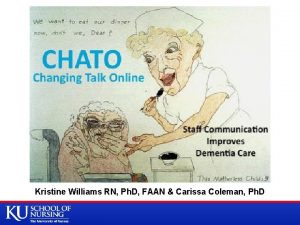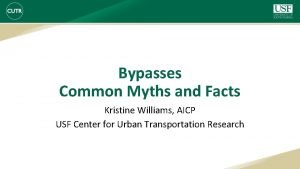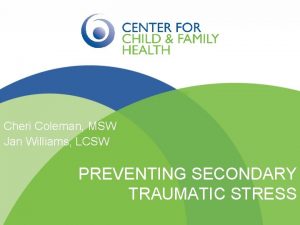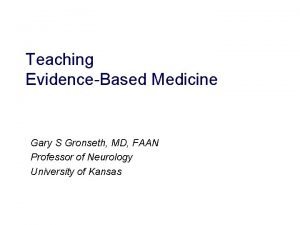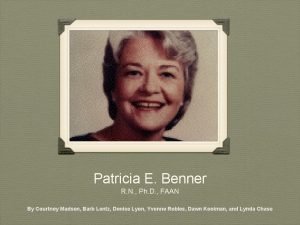Kristine Williams RN Ph D FAAN Carissa Coleman












- Slides: 12

Kristine Williams RN, Ph. D, FAAN & Carissa Coleman, Ph. D

The Changing Talk Online: CHATO Training § CHATO Training: § 3, 1 -hour interactive online sessions § Staff encouraged to take resident point of view § Videos from actual nursing home § Role play & discussion of corrected transcripts § The goal of the CHATO course is to increase awareness of the importance of effective communication with older adults and to use evidence-based, person-centered communication during interactions with older adults in nursing homes and other health care settings. § Educates staff about effective verbal and nonverbal communication strategies for residents with and without cognitive impairment § The course is designed for all staff. Improving the communication climate in your nursing home is best achieved with everyone's participation.

Why is CHATO an important training for our nursing home? Benefits for your organization, your staff, and your residents: § A person-centered approach where residents with and without cognitive impairment feel respected and valued. § Education about elderspeak and better communication strategies. § Reduction in resistiveness to care and other behavioral symptoms in residents with dementia. § Reduction in the need for psychotropic medication § A free, nonpharmacological, evidence-based intervention in a convenient, online educational format for busy nursing homes.

CHATO Research: Elderspeak & Dementia § Early research looked at the communication between 20 nursing home residents with dementia and their staff. They were videorecorded during: Bathing Dressing Oral Care Other daily care § Computer-assisted NOLDUS behavioral analysis of § Resident Behavior (Resistiveness to Care, Cooperative, or Neutral) § Staff Communication (Elderspeak, Normal, or Silence) § Results indicated that residents with dementia were twice as likely to be resistive to care if the staff member was using elderspeak.

Elderspeak: Impact on Dementia Care R 03 NR 009231, National Institute of Nursing Research (NIH) Probability of RTC significantly different p =. 0028

CHATO Research: Classroom CHAT training § Clinical Trial testing effects of CHAT in 13 NHs § Randomized by NH to intervention or wait-list control § Video-Record staff-resident dyads during 2 morning care sessions § Pre-Intervention § Post-Intervention § 2 Month Follow-up § Post-intervention comparisons of behavioral coding § Staff Elderspeak Communication § Resident Resistiveness to Care (RTC) § Results indicated significant decreases of Elderpeak and RTC after training

Findings: Relationship between Elderspeak & Resistiveness to Care

Effects on Psychotropic Medication Use § Nursing Home Quality Compare percentage of long-stay residents receiving antipsychotic in the target periods § Compared two quarters before and two quarters after CHAT intervention § Averaged state (KS) antipsychotic rates for equivalent quarters § Results indicate 23. 7% decrease in medication use at homes that received training vs. 3. 5%

CHAT Effects on Psychotropic Medication Rates Antipsychcotic Prevalence Antipsychotic Use KS Average 28 26 25, 4 24, 5 24 22 20 CHAT Facilities 20, 7 18 16 15, 8 14 12 10 Pre CHAT Post CHAT Decrease 23. 7% in CHAT NHs vs 3. 5% KS

Timeline for CHATO The projected timeline for CHATO is three months: § One month for orientation, team development, and planning. § In month two, staff should complete three modules (suggested one per week). § Staff recognition and follow up should take place in month three. Along with leadership surveys and interviews.

Strategies for Implementing CHATO The CHATO Research Team has compiled implementation strategies to help make CHATO a success in your nursing home. These strategies can be found in the CHATO Implementation Toolkit. § Download at our website: http: //nursing. kumc. edu/chato/resources. html. Toolkit Contents: § The CHATO Training Startup Checklist: A checklist of what to do before, during, and after the CHATO training. Easy Planning! § Communication Plan – examples and downloads to help you engage stakeholders and staff. Gain buy in and support! § Additional Resources that may be supportive before, during, and after implementation.

Additional Support Contact us for questions and troubleshooting § Carissa Coleman, Project Director, ccoleman 3@kumc. edu, 970 -270 -6839 § Kristine Williams, Principle Investigator, kwilliams 1@kumc. edu, 913 -588 -1673



